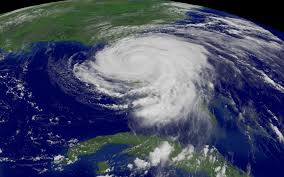Hurricane season is less than a month away. Are you ready?
Written by Meteorologist Mary Wasson
Last updated 5/7/2024, 6:32:18 PM
The start of Hurricane season is just one month away and now is the time to prepare, well before a storm develops.
This week is National Hurricane Preparedness Week and we are going to look at everything you’d need from knowing your risks, planning an evacuation route, and making a disaster kit.
Planning now helps improve the nation’s readiness, responsiveness, and overall resilience against hurricanes during the upcoming season. As the National Weather Service in North Carolina says, “Remember you should prepare EACH and EVERY YEAR, as it only takes ONE storm.”

A tropical cyclone is an organized and rotating system of thunderstorms and clouds that typically forms over tropical or subtropical waters. These weather systems are characterized by a closed low-level circulation and a counterclockwise rotation in the Northern Hemisphere.
- Tropical Depression: maximum sustained winds of 38 mph or less.
- Tropical Storm: maximum sustained winds of 39 to 73 mph.
- Hurricane: maximum sustained winds of 74 mph or higher.
- Major Hurricane: maximum sustained winds of 111 mph or higher, corresponding to a Category 3, 4, or 5 on the Saffir-Simpson Hurricane Wind Scale.
Know your Risk
Tropical cyclones are not just coastal storms, you could be hundreds of miles inland and feel the impacts of wind and water. Be sure to assess if you live in a flood-prone area or an evacuation zone, and identify any structural weaknesses in your home.
- Floodsmart.gov: Understanding Flood Zones
- NOAA’s Coastal Flood Exposure Mapper
- HurricaneStrong: Find Your Evacuation Zone
Prepare Before the Storm
Now is the time to focus on being prepared because waiting until the last minute can be dangerous and could lead to life-threatening situations. Therefore, it's crucial to take action now and get your disaster supplies while the shelves are still stocked. Additionally, don't forget to get an insurance checkup early, as flood insurance requires a 30-day waiting period.

Whether you’re evacuating or sheltering in place, you’re going to need supplies not just to get through the storm but for the potentially lengthy and unpleasant aftermath. Have enough non-perishable food, water, and medicine to last each person in your family a minimum of 3 days. You’ll need extra cash, a battery-powered radio, and flashlights. You may need a portable crank or solar-powered USB charger for your cell phones.
Understanding the Forecast
Know your alerts & the difference between a Watch & Warning. In general, a Watch means impacts are possible; a Warning means impacts are expected or happening.

Get Moving when the Storm Threatens
It's imperative to take immediate action when a storm is predicted to hit your area. The best way to ensure your safety is to have an evacuation plan and disaster supplies before hurricane season begins when there is ample time to prepare and stores are fully stocked.
- Protect your home: board up windows, tie down loose outdoor items, and secure all exterior doors.
- Determine sheltering options: find ones that will allow you to bring your pets.
- Ready your go-bag, meds & supplies, charge phone, fill up/charge vehicle
- Help your neighbors: make sure they know where to evacuate.
- Follow evacuation orders
Stay Protected During Storms
Whether you choose to evacuate or stay put, it's crucial to know what hazards you may face. Stay informed by keeping up-to-date with the latest forecasts and alerts, and don't forget to listen to local officials.

Caution After Storms
Remember that dangers can still exist even after the skies have cleared up after a hurricane. It's important to remain cautious and vigilant in such situations, especially since nearly half of hurricane fatalities occur after the storm has passed. If you evacuated, please don't return home until you're told that it's safe to do so.
When you return home, be careful around damaged buildings and check your surroundings for loose power lines, gas leaks, and structural damage. It's also important to avoid floodwaters as they can contain harmful bacteria, chemicals, sharp objects, and dangerous animals. Don't drive through flooded roads, and stay clear of downed power lines to avoid electric shock. If you detect a gas smell, immediately call 911 and evacuate your home.
If you plan to use a portable generator, please ensure it's being used outside and at a distance of more than 20 feet from your home, doors, and windows. Carbon monoxide poisoning can be fatal, and it's one of the leading causes of death in areas dealing with power outages.
It's also important to remember that communication systems may be impacted after a hurricane, and it could take hours or days for emergency responders to reach your area. Try to communicate via text, email, or social media if possible, and don't forget to check on your neighbors as well.
Dangerous rip currents can occur even when a storm is out to see. Follow these special tips to stay safe:

Last year, the Atlantic saw 20 named storms, which ranks 4th for the most named storms in a year since 1950. Of those storms, 7 were hurricanes, and 3 intensified to major hurricanes.
According to the National Weather Service, an average season has 14 named storms, 7 hurricanes, and 3 major hurricanes. This year’s Colorado State University forecast has 23 named storms, 11 hurricanes, and 5 major hurricanes.